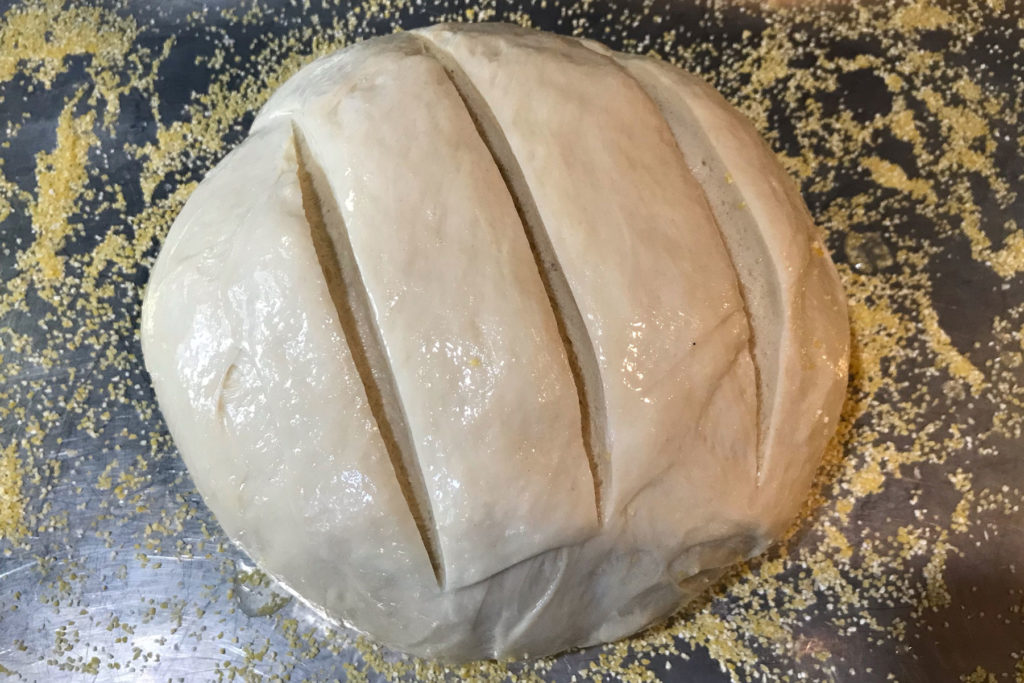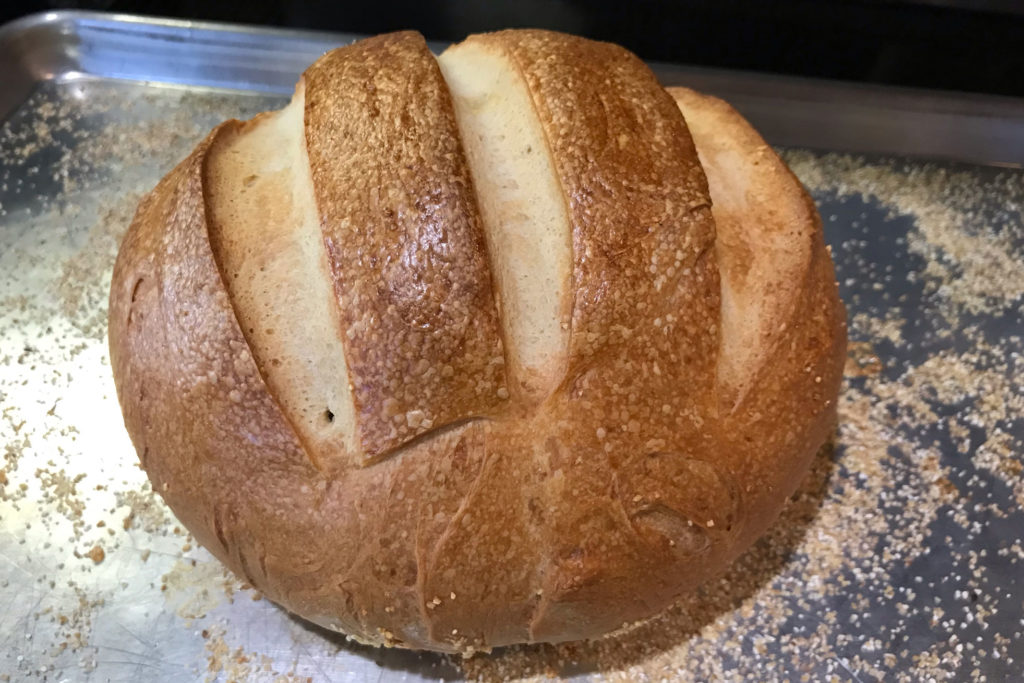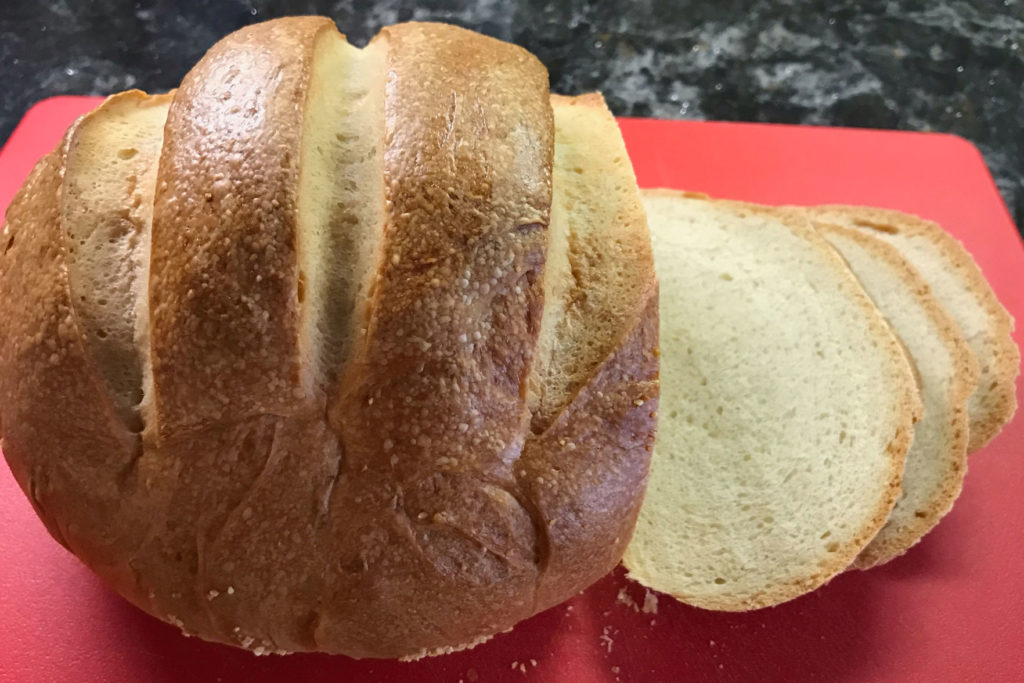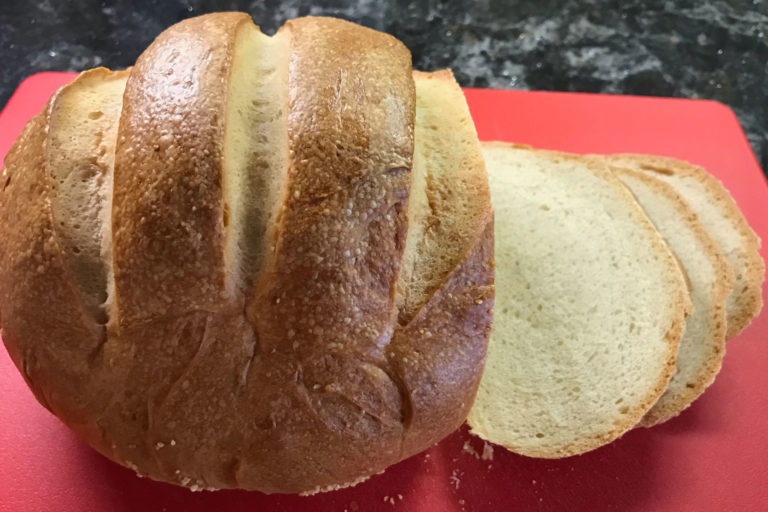This was the seventh loaf I baked from Beard on Bread. (This is a continuation of my silly little project that involves trying every recipe in this classic cookbook. I started documenting my trials and tribulations after my fourth loaf.) See the bottom of this post for Beard’s recipe.
The set-up and the prep
Beard explains in his headnote to this recipe that he was testing a version of the free-form (not the version I made a few weeks earlier) when he made a mistake that “proved to be extremely interesting.” That mistake was turning his oven to “broil” instead of “bake.” He described the unintended result as “browning magnificently” in the oven and having a “beautifully brown, crisp top crust” and a loaf that “tasted absolutely wonderful, and the upper crust was superb.” That is some hype!,” I thought. I wonder if my result would be as magnificent and wonderful.
Before I discuss the actual prep, I must share the yeast conversion chart I’ve been using: Yeast Conversions for Recipes from The Spruce Eats. Since I’m often using instant yeast not packaged in individual envelopes, I turn to this article often to make sure I’m using the correct amount when a recipe uses envelopes of yeast as the only measure of the required quantity of yeast.
Alas, for this loaf I’m not sure I got the yeast amount right. I still have the scrap of paper I used for my calculations and I somehow concluded 4 teaspoons would be the correct amount for the recipe, though 5.5 teaspoons should have been the amount … right???
Anywho, nothing interesting to note except it seems kneading dough seems to take a toll on on my KitchenAid mixer, which seems to jerk around a lot during kneading. Though I can’t say for sure that the kneading has anything to do with this, the metal mixing bowl I use with the mixer now seems permanently attached to the mixer; neither me nor my husband can get the bowl off the mixer! Coincidence? Hmmm.
The two bowl risings were uneventful; the first went for 2 hours, the second about an hour and a half.
And, oh yes, I finally got a lame! So I was able to give the loaf a few good slits before it went in the oven:

The gnarliest part of this production was interpreting Beard’s baking instructions for use with my oven. My broiler has a high and a low setting, but no way to specify a particular temperature. I started with the broiler on high, and, starting to see dark colors develop on the loaf rather early on, I chickened out and changed the broiler setting to low after just seven minutes. And on low broil for only two minutes before I gave in and turned off the broiler setting altogether. But, then … for how much longer should the loaf bake? No idea! After 25 minutes I wanted to try knocking on the bottom of the loaf, but the loaf was sticking to the pan. Grr. So I quickly looked up a few similar bread recipes that gave target internal temperatures to determine whether or not the loaves were done. I decided to go with a target of 200 degrees F. After 15 minutes more I took the loaf out and carefully pried it off the pan. Total baking time, including the time under the broiler: 49 minutes.
The result
A nice dark-ish loaf … I can’t help but wonder if I made the slits a bit too deep.

The crust was very nice, but perhaps not as crisp as Beard’s versions. The bread was OK untoasted, and pretty good toasted (with a good chew), but it definitely needed some sort of topping, for the flavor profile of an unadorned slice was, to me, salt. Not salty, just salt. Not all that pleasant. Oh well.
The finished loaf weighed 1.75 pounds.

White Free-Form Loaf
[1 free-form loaf]
2 packages active dry yeast (I, perhaps erroneously, used 4 teaspoons SAF Red Instant Yeast [see “The set up and prep” section above].)
¾ cup warm water (100° to 115°, approximately)
4 cups unbleached all-purpose flour
1½ tablespoons coarse salt
3 tablespoons olive, vegetable, or peanut oil
½ cup buttermilk
Cornmeal
1 egg white, beaten with 1 tablespoon waterDissolve the yeast in the warm water and let it proof. Measure the flour into a mixing bowl, add the salt, and blend well. Add the yeast and blend thoroughly, preferably with your hands. Add the oil, and then, gradually, the buttermilk. Mix with the hands or in an electric mixer with a dough hook until the dough comes off the bowl. Turn out onto a lightly floured board and knead for 10 minutes, until the dough is smooth and resilient. Remove to a buttered bowl and turn to coat the surface with butter. Cover and let rise until doubled in bulk.
Punch the dough down, knead for 3 minutes, and let rise once more. Punch down again, then, using both hands, gather the dough into a big circular package, draw the top together to close it, and pinch the ends together. Turn the dough over, and set it, pinched-end side down, on a baking sheet sprinkled with cornmeal, and let rise until doubled in bulk. (Cornmeal may be sprinkled on the top, too, for for an extra accent.) Slash the top in three places and brush with the egg wash. Broil at 375° for 20 minutes, then switch to “bake” for 25 minutes, or until the loaf sounds hollow when tapped with the knuckles. (If your broiler has no setting, place the bread as far as possible from the unit and watch carefully. You may have to switch from “broil” to “bake” more quickly.) Remove the loaf from the baking sheet and let it rest directly on the oven rack for a few minutes to brown the bottom. Cool on a rack.
Beard on Bread, James Beard, Knopf, 1974, p.40–41
Broiled White Free-form Loaf recipe from Beard on Bread by James Beard. Alfred A. Knopf, New York, 1974, p.40–41.
